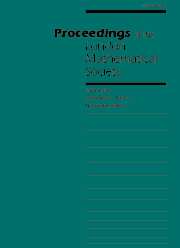Article contents
Differences betweenconsecutive primes
Published online by Cambridge University Press: 01 January 1998
Abstract
Let $p_n$ be the $n$th prime. Then this paper is concerned with proving the following result on the distribution of consecutive primes.
Theorem.}\begin{equation}\sum_{p_{n+1}-p_n>x^{\frac 12},\ x \leq p_n \leq 2x} (p_{n+1}-p_n) \llx^{\frac{25}{36}+\epsilon}.\end{equation}
The exponent of $x$ in this theorem improves on the work of Heath-Brown who proved $(1)$ with exponent $\frac 34$. Under the Riemann hypothesis one can prove$(1)$ with exponent $\frac 12$.The proof of the theorem starts with the Heath-Brown--Linnik identity which leads to a formula giving the number of primes in an interval in terms of coefficients of certain Dirichlet series. I then estimate the coefficients by using, among other things, the information which can be gained from Montgomery's mean value theorem and Huxley's version of the Hal\' asz lemma. Furthermore, by using familiar sieve arguments I am able to discard some of the coefficients allowing us to gain an improvement over the previous result of Heath-Brown.
1991 Mathematics Subject Classification: 11N05.
Keywords
- Type
- Research Article
- Information
- Copyright
- London Mathematical Society 1998
- 8
- Cited by


